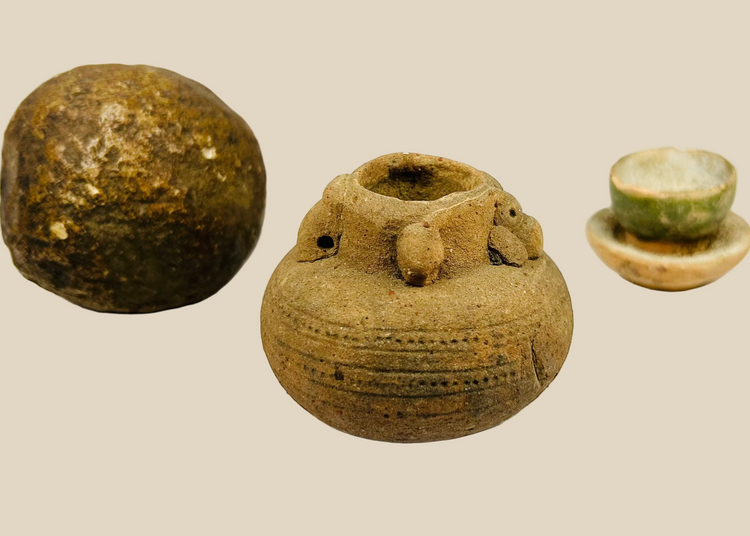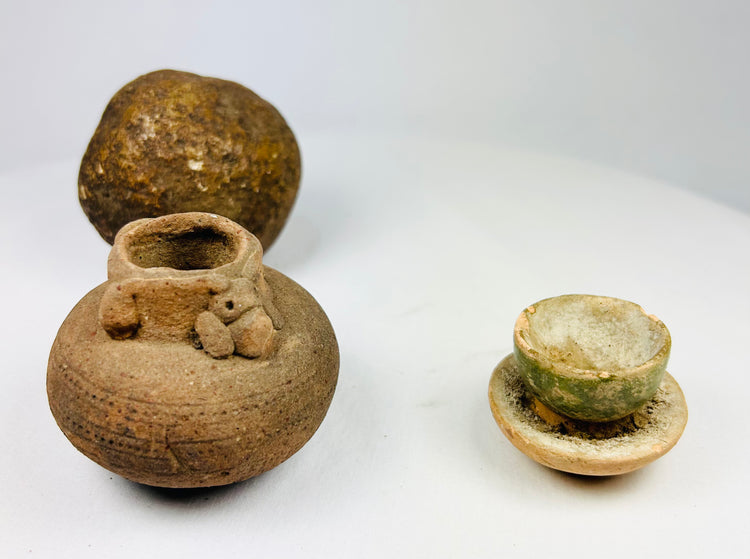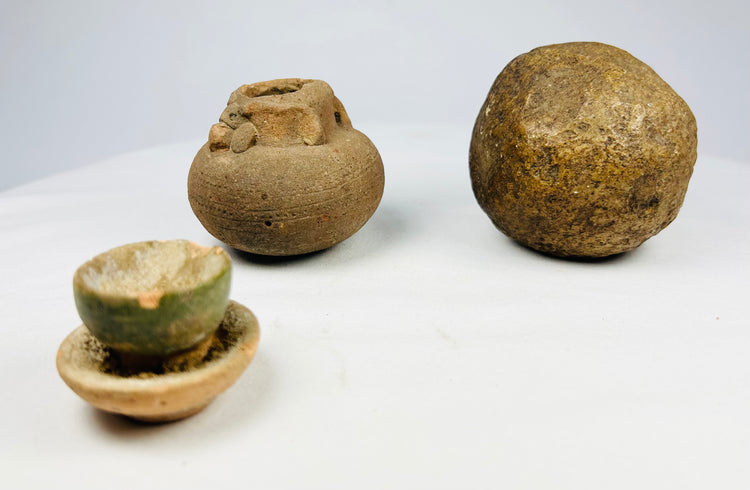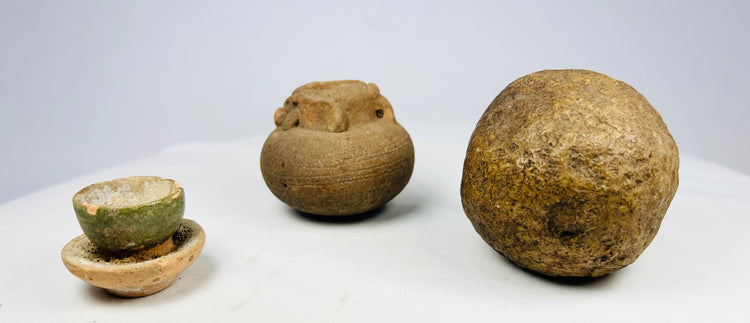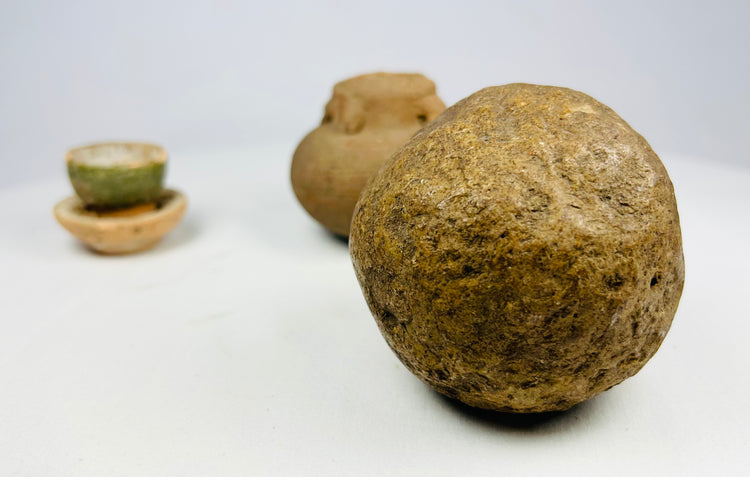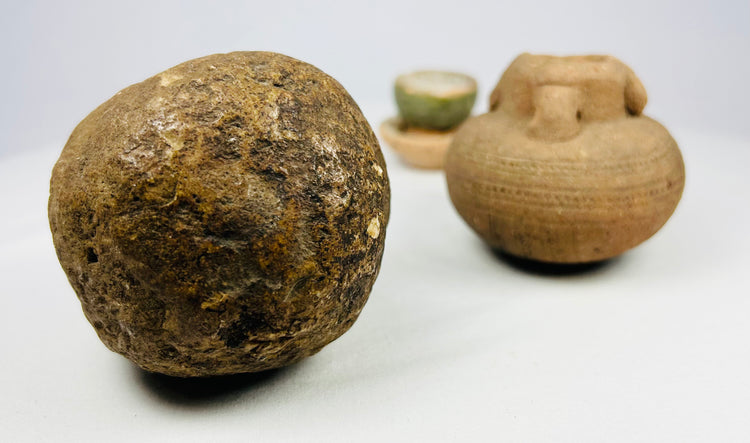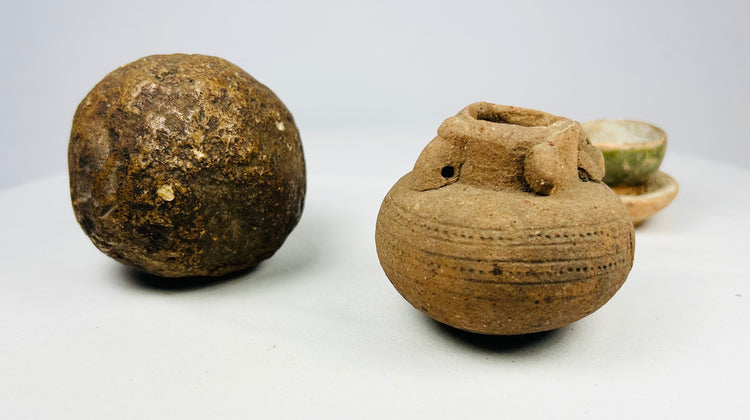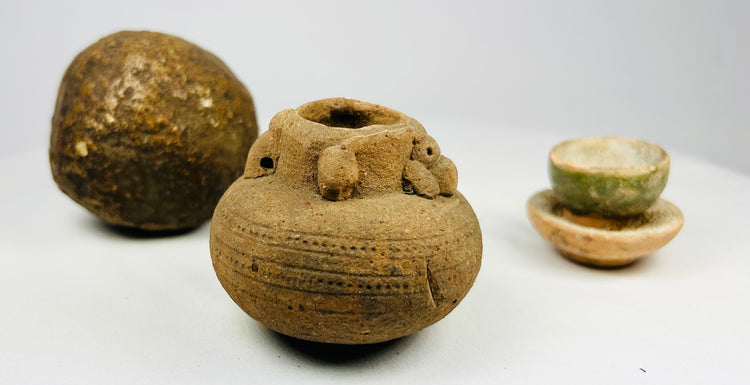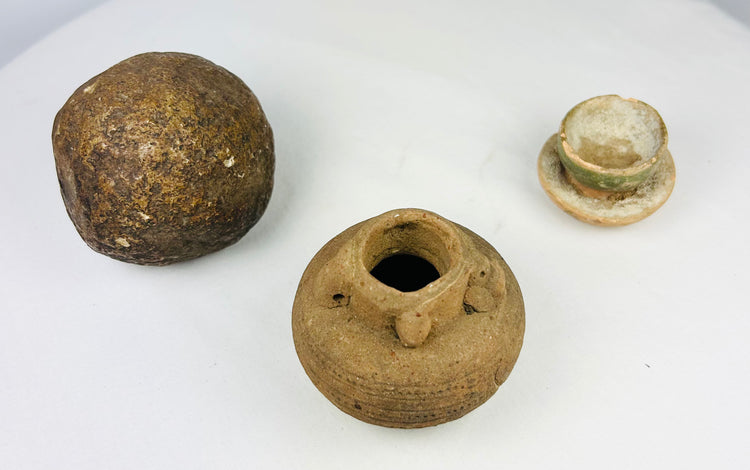Trio of Early Ceramics and Stone Artifacts | South and East Asia | Circa 500–1500 CE
Description
More
Less
Spherical Stone Object
Region: Southeast Asia or Indian Subcontinent
Material: Dense stone with natural patina
Period: Undetermined; possibly several hundred to over 1,000 years old
Description
A smooth, rounded stone of dense composition, carefully shaped into a near-spherical form. Its tactile surface and even wear suggest utilitarian use, possibly as a grinding implement, pestle, or projectile in early human subsistence activities. The stone bears natural weathering marks and surface patina from prolonged exposure to the elements.
Features
- Spherical form for grinding or striking functions
- Natural patina and weathering consistent with age
- Tactile quality typical of hand-utilized tools
- Example of practical, early human design
Cultural Significance
Such spherical stones were commonly employed in ancient domestic and hunting contexts across Southeast Asia and the Indian subcontinent. They embody the practical ingenuity of early societies, bridging the line between utilitarian tool and cultural artifact.
Condition
Stable, with natural wear, surface smoothing, and weathering patterns consistent with extended use and burial.
Dimensions (approximate)
Diameter: 3 in
Age
Unknown; possibly several centuries to over 1,000 years old
Miniature Ceramic Jar
Region: South or Southeast Asia
Material: Reddish-brown terracotta with incised decoration
Period: Iron Age to Medieval period, ca. 500–1500 CE
Description
A small hand-formed jar crafted in reddish terracotta, with dotted-line incised ornament and raised features. The vessel’s petite scale suggests use for storing oils, perfumes, or other precious substances. A fine example of functional yet decorative ceramic work, it has survived with a visible ancient crack and minor wear but remains structurally intact.
Features
- Miniature jar with dotted-line and raised decorations
- Reddish-brown terracotta body
- Small, functional form likely for domestic or ritual storage
- Surface wear and mineral traces attesting to age
Cultural Significance
Miniature vessels such as this were significant both in household ritual and daily life. Their small size made them practical for personal or ceremonial use, particularly for storing perfumes, ointments, or sacred oils.
Condition
Good condition with age-consistent wear, minor cracks, and surface abrasions. Structurally sound.
Dimensions (approximate)
Height: 2.5 in
Age
Circa 500–1500 CE
Miniature Green-Glazed Cup with Stand
Region: China or Neighboring East Asian region
Material: Ceramic with green glaze
Period: Early to Mid-2nd Millennium CE
Description
A delicate ritual cup raised on a pedestal stand, finished with green glaze now softened by age. The form suggests ceremonial use—either as an offering vessel, incense holder, or ritual cup. The glaze shows chipping and rim wear, enhancing the authenticity of its use and age.
Features
- Small pedestal cup with green glaze
- Signs of ritual use: rim wear and glaze loss
- Functional ceremonial form with balanced proportions
- Example of East Asian ritual ceramic craftsmanship
Cultural Significance
Green-glazed pottery was a hallmark of ritual culture in China and neighboring regions, used for temple offerings and domestic ceremonies. The vessel reflects the symbolic and devotional role of ceramics in religious life during the 2nd millennium CE.
Condition
Age-consistent wear including rim chipping, glaze loss, and surface abrasions. Stable and displayable.
Dimensions (approximate)
Height: 3 in
Age
Early to Mid-2nd Millennium CE
Description
Spherical Stone Object
Region: Southeast Asia or Indian Subcontinent
Material: Dense stone with natural patina
Period: Undetermined; possibly several hundred to over 1,000 years old
Description
A smooth, rounded stone of dense composition, carefully shaped into a near-spherical form. Its tactile surface and even wear suggest utilitarian use, possibly as a grinding implement, pestle, or projectile in early human subsistence activities. The stone bears natural weathering marks and surface patina from prolonged exposure to the elements.
Features
- Spherical form for grinding or striking functions
- Natural patina and weathering consistent with age
- Tactile quality typical of hand-utilized tools
- Example of practical, early human design
Cultural Significance
Such spherical stones were commonly employed in ancient domestic and hunting contexts across Southeast Asia and the Indian subcontinent. They embody the practical ingenuity of early societies, bridging the line between utilitarian tool and cultural artifact.
Condition
Stable, with natural wear, surface smoothing, and weathering patterns consistent with extended use and burial.
Dimensions (approximate)
Diameter: 3 in
Age
Unknown; possibly several centuries to over 1,000 years old
Miniature Ceramic Jar
Region: South or Southeast Asia
Material: Reddish-brown terracotta with incised decoration
Period: Iron Age to Medieval period, ca. 500–1500 CE
Description
A small hand-formed jar crafted in reddish terracotta, with dotted-line incised ornament and raised features. The vessel’s petite scale suggests use for storing oils, perfumes, or other precious substances. A fine example of functional yet decorative ceramic work, it has survived with a visible ancient crack and minor wear but remains structurally intact.
Features
- Miniature jar with dotted-line and raised decorations
- Reddish-brown terracotta body
- Small, functional form likely for domestic or ritual storage
- Surface wear and mineral traces attesting to age
Cultural Significance
Miniature vessels such as this were significant both in household ritual and daily life. Their small size made them practical for personal or ceremonial use, particularly for storing perfumes, ointments, or sacred oils.
Condition
Good condition with age-consistent wear, minor cracks, and surface abrasions. Structurally sound.
Dimensions (approximate)
Height: 2.5 in
Age
Circa 500–1500 CE
Miniature Green-Glazed Cup with Stand
Region: China or Neighboring East Asian region
Material: Ceramic with green glaze
Period: Early to Mid-2nd Millennium CE
Description
A delicate ritual cup raised on a pedestal stand, finished with green glaze now softened by age. The form suggests ceremonial use—either as an offering vessel, incense holder, or ritual cup. The glaze shows chipping and rim wear, enhancing the authenticity of its use and age.
Features
- Small pedestal cup with green glaze
- Signs of ritual use: rim wear and glaze loss
- Functional ceremonial form with balanced proportions
- Example of East Asian ritual ceramic craftsmanship
Cultural Significance
Green-glazed pottery was a hallmark of ritual culture in China and neighboring regions, used for temple offerings and domestic ceremonies. The vessel reflects the symbolic and devotional role of ceramics in religious life during the 2nd millennium CE.
Condition
Age-consistent wear including rim chipping, glaze loss, and surface abrasions. Stable and displayable.
Dimensions (approximate)
Height: 3 in
Age
Early to Mid-2nd Millennium CE
You May Also Like


























